
University Residence
"Colegi Mayor Rector Peset" & Botanical Garden
University of Valencia (Spain),
September 24 - 27, 2007

 |
University Residence University of Valencia (Spain), September 24 - 27, 2007 |
 |
|
La Lonja de la Seda |
|
|
|
La Lonja was declared a UNESCO World Heritage
Site in 1996 for being one of the most stunning, most important and best
preserved examples of Late Gothic architecture in entire Europe. Built in the
beginning of XVI century, La Lonja (Silk Exchange) is the real emblem of the
Golden Age of Valencia - the times when this city was one Europe's main cultural
and economic centres - and this is precisely why La Lonja was built. As such, no
expense was spared on the lavishness and luxury of the architecture here. It is impossible to be unimpressed by La Lonja and that is why it is a must on any travel itinerary. La Lonja is a dramatic and ingenious blend of medieval castle mounmentalism and an exquisite sophistication of the epoch art. It both inspires awe with its imposing glamour, and seduces you with its elaborate playful ornaments. It is both powerful and light-hearted, both solemn and sparkling with life. La Lonja is composed of three parts (plus the Orange Garden - a walled court-yard). The main hall, Sala de Contratacion (The Contract Hall) is an enormous, lavishly decorated space supported by gorgeous twisted columns. This was the centre of life in La Lonja, the place where the merchants would meet, deal and sign. The side-wing is named the Pavillion of the Consulate, and this was the seat of the Tribunal del Mar - the first merchant tribunal to ever be formed in Spain. The first two floors were the main function rooms, with the upper one hosting a richly decorated ceiling - a masterpiece of medieval art which had the King ride out of the capital just to see it. These rooms are still authentically furnished. On occasions, the Tribunal would imprison merchants for debts in the central tower of La Lonja - the third part of the structure. |
|
Mercado Central - Central Market in Valencia |
|
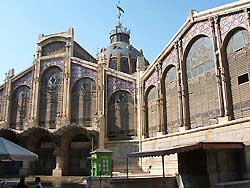 |
Right opposite La Lonja, this is one of the oldest running food markets in Europe, although the building itself was constructed in the beginning of the XX century, in genuine Valencian style, with lots of colours, ceramics and mosaics. It is really worth seeing - go all the way around it to appreciate different angles. The market is still as lively as ever, as if centuries have not passed by. A snapshot of real Valencian daily life and, needless to say, a perfect place to buy some local delicacies. |
|
Iglesia de Santos Juanes |
|
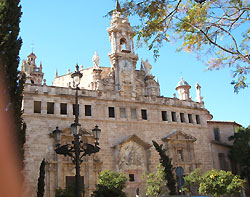 |
Iglesia
de los Santos Juanes is one of the oldest in Valencia and is a National Heritage
site. When you view Mercado Central and La Lonja you won't be able to miss this
impressive church that completes the triangle. Look at it from La Lonja and you
will be amazed by the beauy of its elaborate Baroque facade and complexity of
its detail. Walk behind it and it becomes something entirely different - an
almost deserted, simple, huge and monumental Gothic structure, a ghost-like
ambience. A very curious building. History: the first church was built in 1240 on the site of an old mosque. It was consequently modified in 14th and 16th centuries, with the baroque element appearing in 17th century. |
|
Sta Catalina Tower |
|
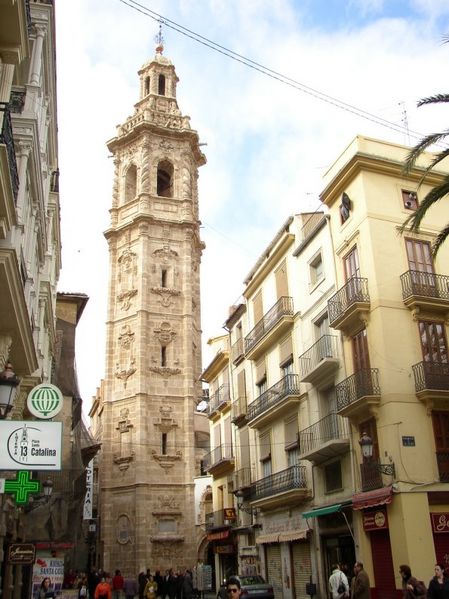 |
They call El Micalet and Sta Catalina "husband and wife".
Perhaps because both are very close to each other (both on Plaza de la Reina)
and in some ways similar, yet the Baroque tower of Sta Catalina church holds a
more light-hearted and elegant ornament, and a more fuid shape, in contrast to
the sturdy and solemn Micalet. Sta Catalina is one of Valencia's landmarks, one of
the most beautiful buildings in Carmen and an unforgettable sight in the sunny
Spanish afternoon. The church interior is also worth visiting, the small,
genuine Old Gothic space with coloured windows. SERVICES only religious: weekdays 10.30, 13.00, 18.30; Sun + Hols 11.30, 12.30, 13.30, 18.30. In July no mass at 10.30 |
|
The Cathedral - La Catedral de Valencia |
|
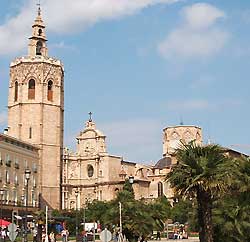
|
Centrally located on
the Plaza de la Reina, this is the religious centre of Valencia and one of the
city's landmarks, not to mention they have the Holy Grail here! First founded in 13th century on the
site of the main mosque, right after the Re-conquista, it is a spectacular
hybrid of styles, from Gothic to Baroque and Neo-Classical, with 3 portals to
suit each style. The Baroque facade is the most recycled image, but do walk
around it all to fully appreciate it - every side of it is a different mood,
from shady fortress-like West side, to the Gothic Portal of the Apostles on
Plaza de la Reina, to the cosy narrow street passageways on the East side. Religious services in the Cathedral: Mass at 8.00, 9.00, 10.00, 11.00, 12.00, 18.00, 19.00, 20.00. From June to October extra service at 13.00 |
|
Plaza de la Virgen |
|

|
In the City of
Contrasts, Plaza de la Virgin dominates one end of the spectrum as the
counterweight to the City of Arts and Sciences. It is seen by many as the
ultimate impression of the traditional Valencia of the past centuries. Religious service in the basilica: 8.30, 9.30, 10.30, 11.30, 12.30, 13.30, 17.30, 18.30, 19.30, 20.30 every day.
|
Crypt of San Vicente Martyr |
|
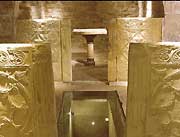 |
The Crypt of San Vicente is one of the most ancient parts of Valencia. Originally a Visigoth chapel from 6th century AD, it was converted into palace baths during the Muslim rule. After the reconquista King Jaime built a chapel on the remains, dedicated to San Vicente Martyr. In addition to the cross-shaped restored Visigoth chapel, the crypt also hosts a part of Roman house ornament, left from the surrounding houses of the Roman nobles, and a corner of a huge Visigoth cathedral this structure was a small part of. As such, the crypt truly spans the entire history of Valencia and is a treat for a history lover. Normally you can just walk in and see the ruins. However, on their own they are silent and might not impress you that much unless you really know your archaeology. |
|
Admiral's Baths |
|
|
|
The Admiral's Baths were built in 14th century. Although
constructed by Christians shortly after the reconquista, they were built to an
Arab model and used as public baths since then until 1959. Valencia had 10-15
similar baths in old times but Banos Almirante are the only one that survived. Now fully restored, the baths are a pleasant and calming spectacle. You will be shown a short video of the history and the process of bathing. After you have seen all the rooms (with explanations) you will view the characteristic roof and a computer generated model of how Banos Almirante functioned. All viewing is a 25 min audio-tour at specific times (every half an hour). Although it might not be the most fascinating subjects, this installation gives you a relaxing and curious half an hour. An oasis of tranquility in the middle of the city, there is something Zen about it. Somehow, you come out feeling like you've just had a bath and ready for more walking. The door will remain closed until the previous tour is finished, so wait outside. |
|
Torres de Serranos |
|
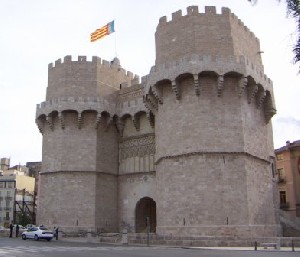 |
The imposing Torres de Serranos are one of the
landmarks of Valencia. Their awe-inspiring enormity and the elegance of Gothic
style are truly worth your time. One of the two remaining city gates from the
XIV century, they were built by one of the most talented Gothic architects of
those times. You can walk through its many levels right to the top, appreciating
stunning gothic interior, ancient ornaments, military pragmatism and views over
the rest of Valencia. The rear of the towers are open, and you can enjoy the
panorama of the interior. |
|
Torres de Quart |
|
 |
The Torres de Quart is another remainder of the old city walls, on pair with the Torres de Serranos. Quite different, they were built a little later, in the Late Gothic style, also with a defensive function. Unlike Torres de Serranos though they did came to perform that function in 19th century - the gates were Napoleon's point of entry into the city. The towers used to bear the scars of his cannon balls until the recent restoration. Just as imposing as the Torres de Serranos, they are more difficult to appreciate though, being cramped in the small spaces of Carmen, but it gives them a certain domestic charm that Torres de Serranos don't have in their wide space. |
Colegio San Pio V |
|
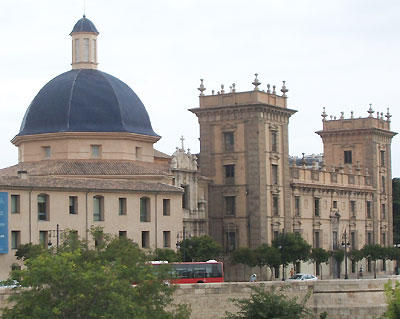 |
The building, which is these days better known as the Museum of Fine Arts (Museo de las Bellas Artes) is an unforgettable view from across the river, when you are walking along the Northern side of the centre. Its postcard exterior of a large blue dome and twin square towers is complemented with a luxurious interior cupola and Renaissance inner patios. Built in 17th century as a clergy college, it finally became the Museo de las Bellas Artes in 1940, currently hosting the second most important art collection in Spain. |
Bullring + Train Station |
|
 |
The
Bullring and the Train Station are coupled because they are right next to each
other and if you see one you migth as well see the other. The Bullring has been the centre of Valencia's bull-fighting for almost 150 years now. It is a large, impressive structure in the style of a Roman Coliseum but employing Doric ornament (the traditional Ancient Greek style). With only the ring itself measuring 52 m in diameter, it is much larger as a whole, with 4 levels of colonnades and ballustrades. Inside, the ancient Spanish culture breathes at you from the sand of the ring. However, access to the interior is via the Bullfighting Museum only. When there are no bull-fights the bullring hosts an occasional fair, concert or circus, and closes the rest of the time. The Train Station, lame as it sounds, is actually a very interesting building worth popping into if you pass by. Built in 1917 with Neo-Gothic influence in the structure, it hosts an entire caleidoscope of typically Valencian mosaics and ceramics on the themes of Valencian countryside, making it a glimpse into the local culture. |
|
The City of Arts and
Sciences |
|
|
Everyone has seen Baroque, Rennaisance, Gothic...It got boring. How many people can come back from their holiday and boast about the 22nd century architecture they enjoyed on their trip? No pictures will do it justice. This is one of those things you have to see no matter how much you hate the crowds and tourist traps, like the Sagrada Familia of Barcelona or Machu Picchu of Peru. Only this time you are transported into the future, not into the past. The City of Arts and Sciences is a huge futuristic educational complex designed for Valencia by the famous Spanish architect Santiago Calatrva, as a present to his home city. Calatrava's vision is that of the space age, inspired by animal skeletons. You can enjoy it for free, unless you want to go inside and explore what it has to offer - the City is much more than the pretty face, offereing amazing entertainment and education on an unprecendeted in Europe level. The City of Arts and Sciences is composed of 5 elements (below), all bound together in a luxurious lanscape of clear water spaces and greenery. It is truly a city withing a city - you will find yourself far, far away from Valencia, on some distant planet in a distant time. Some parts around it are still work in progress - the 6th and final construction has only just commenced and thats why the park around the Oceanographic has to wait to be completed. Although this makes a few corners unsightly, generally it doesn't make a big impact on the stunning experience you will receive. |
|
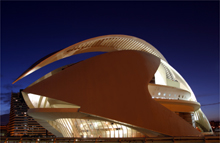 |
Palau de les Arts Reina Sofia
(The Concert / Opera Hall) |
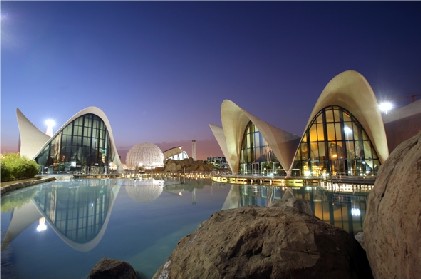 |
L'Oceanografic
(The Marine Park) |
 |
L'Hemisferic
(The IMAX Cinema) |
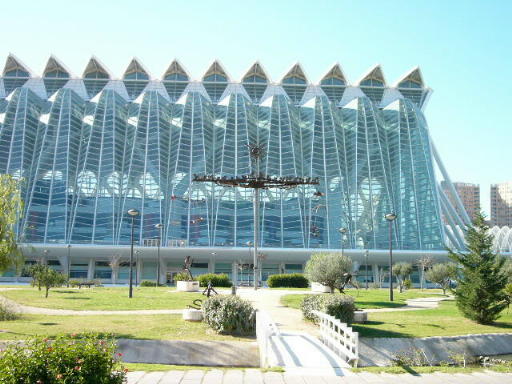 |
Museo de Ciences Principe Felipe
(The Museum of Science) An enormous long structure with 3 Floors of ultra-interactive science material on topics like electricity, physical laws, lasers, human body, sport sciences, sound, lights, planetarium, and many others. Some stuff is purely fun, other takes good brain work, all of it is fascinating. Unlike in other museums, the rules here are - pull, push, touch, twist. Most of the exhibition is permanent, with a couple of rotating temporary sections. Prices. The City of Arts & Sciences operates a complex price system which will give you discounts if you choose more than one installation. The tickets are valid for two (even if non-consecutive) days - you simply can't enter the same place twice. |
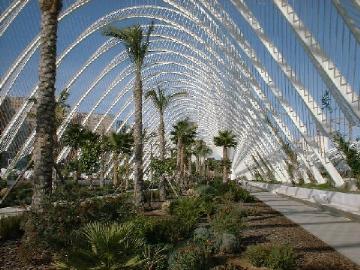 |
L'Umbracle
(The Greenhouse) |
| America's Cup Port | |
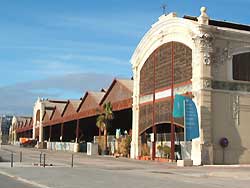
|
Valencia
has the second busiest commercial port in Europe, and sea-trade has always
been a huge part of the city's life. The port is part of what Valencia is. However, now more than ever, the port is the real emblem of today's Valencia, the metaphore for the City of Contrasts, where the past and the future have come to meet. Many travellers never discover the Port for themselves and those that do are surprised it is not covered in the tourist literature. The Old Port is an atmospheric, sleepy complex of traditional ship yards built in the typical Valencian style. Dominated by the charming Clock Building (Edificio del Reloj) it transports you to the nostalgia of the turn of the XX century Valencia, self-contained and secluded within its own culture. The newest addition - the America's Cup Port - is a magnificent futuristic project in the style of Calatrava (the architect of City of Arts and Sciences) - the emblem of New Valencia: a cosmopolitan city firmly on the map of Europe. There is more information on the America's Cup Port infrastructure in the America's Cup section. It is generally a pleasant area for a promenade. Apart from the architecture there are great views onto the docks, the sea and the beach, as well as modern bars and restaurants. You could also combine it with a visit to the nearby Gothic Shipyards, the Church of Santa Maria del Mar, unique architecture in Calle de la Reina, the best paella in Spain on the adjacent end of the beach, or simply with some beach time. |
More information about Valencia in: Valencia City Travel Guide - a comprehensive online guide to sights, tourist attractions, accommodation, travel, nightlife, culture, restaurants and shopping.